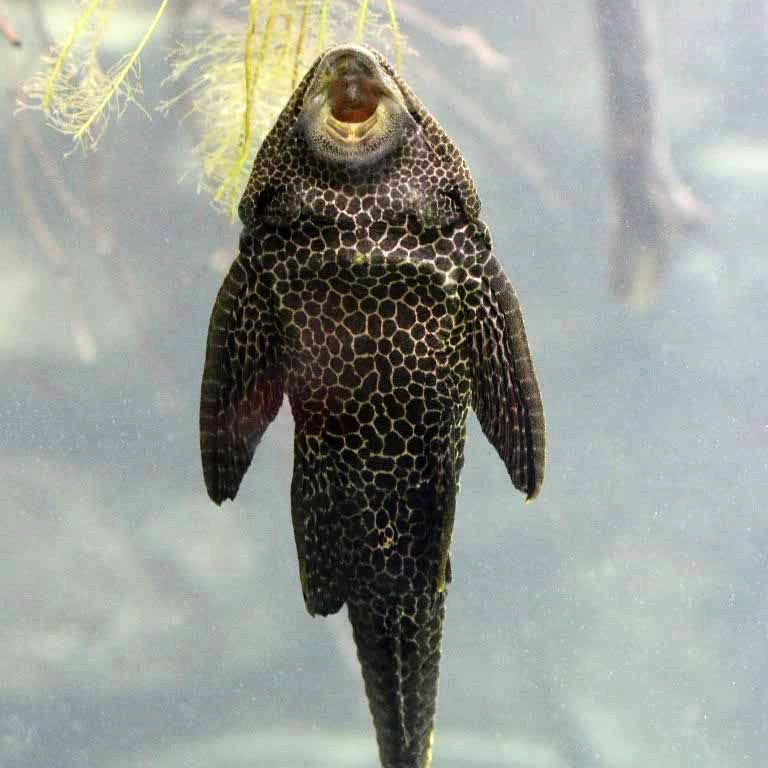Pleco Catfish Hypostomus plecostomus, Pterygoplichthys etc.



Several similar-shaped catfish are called "plecos" though they are in different genera. They are named after the
Common Pleco, Hypostomus plecostomus. Most are cryptically-patterned (for camouflage), armoured, medium-sized catfish, all native to
the Americas.



All have the underside suckermouth.
 This may be a Common Pleco, Hypostomus plecostomus, after which all the others
are named. Its colour and spots vary from light to dark. It is native to the Orinoco basin and grows to 25cm long.
This may be a Common Pleco, Hypostomus plecostomus, after which all the others
are named. Its colour and spots vary from light to dark. It is native to the Orinoco basin and grows to 25cm long.
 Despite the scientific name Pterygoplichthys pardalis, the name "Leopard Sailfin" is usually
given to the Spotted Sailfin or Gibbiceps; the one above is usually called the Amazon Sailfin, although most plecos are spotted
and native to the Amazon.
Despite the scientific name Pterygoplichthys pardalis, the name "Leopard Sailfin" is usually
given to the Spotted Sailfin or Gibbiceps; the one above is usually called the Amazon Sailfin, although most plecos are spotted
and native to the Amazon.
 This grey, spotted fish may be the Sultan Pleco, L264, Leporacanthicus joselimai native to clear
waters of Brazil's Tapajos river. Or it may be another grey, spotted pleco.
This grey, spotted fish may be the Sultan Pleco, L264, Leporacanthicus joselimai native to clear
waters of Brazil's Tapajos river. Or it may be another grey, spotted pleco.
 This may be the Giant White-spotted Pleco, Hypostomus regani of the Parana basin, growing to 40cm long.
Similar is also the Yellow-spotted Hypostomus H. margaritifer, also of the Parana basin (to 33cm long and deeper-bodied) and even
the Pearl-spotted Angel Pleco, Hypancistrus margaritatus or L404, of the Amazon, among others.
This may be the Giant White-spotted Pleco, Hypostomus regani of the Parana basin, growing to 40cm long.
Similar is also the Yellow-spotted Hypostomus H. margaritifer, also of the Parana basin (to 33cm long and deeper-bodied) and even
the Pearl-spotted Angel Pleco, Hypancistrus margaritatus or L404, of the Amazon, among others.
 Above is one of the Cloud Plecos, Scobiancistrus spp., thought to be the White-spotted Moon Pleco, L368,
native to clear-water tributaries of the Amazon in NW Brazil.
Above is one of the Cloud Plecos, Scobiancistrus spp., thought to be the White-spotted Moon Pleco, L368,
native to clear-water tributaries of the Amazon in NW Brazil.
 The White-spotted Moon Pleco (L368) can also look similar to the Golden Cloud Pleco, S. pariolispos or L048/L133,
whose spots can be pale gold or white, as well as other white-spotted plecos.
The White-spotted Moon Pleco (L368) can also look similar to the Golden Cloud Pleco, S. pariolispos or L048/L133,
whose spots can be pale gold or white, as well as other white-spotted plecos.
 Parana Pleco?, L113, Megalancistrus parana of Parana River, Argentina, grows over 50cm.
(Similar to Dragon Hi Fin, L234, of Sao Francisco river, Brazil, but darker with lower dorsal fin.)
Parana Pleco?, L113, Megalancistrus parana of Parana River, Argentina, grows over 50cm.
(Similar to Dragon Hi Fin, L234, of Sao Francisco river, Brazil, but darker with lower dorsal fin.)
 Juvenile Spotted Sailfin. Juveniles usually have larger spots.
Juvenile Spotted Sailfin. Juveniles usually have larger spots.
 This may be a Gibbiceps - see separate page.
This may be a Gibbiceps - see separate page.
There are hundreds of species of "pleco-type" catfish, including many known but still undescribed.
Many look similar. Some appear on other pages of the site.

